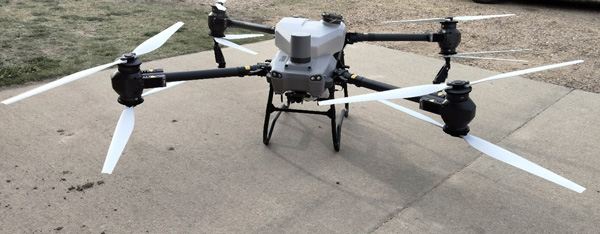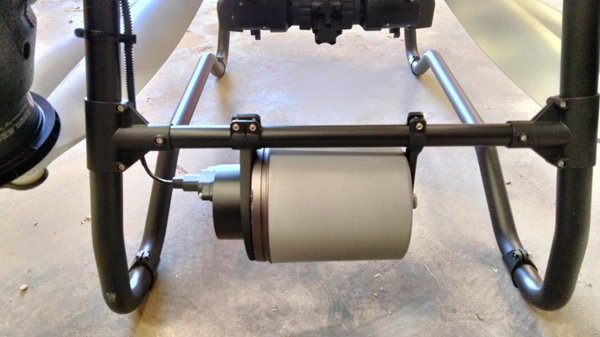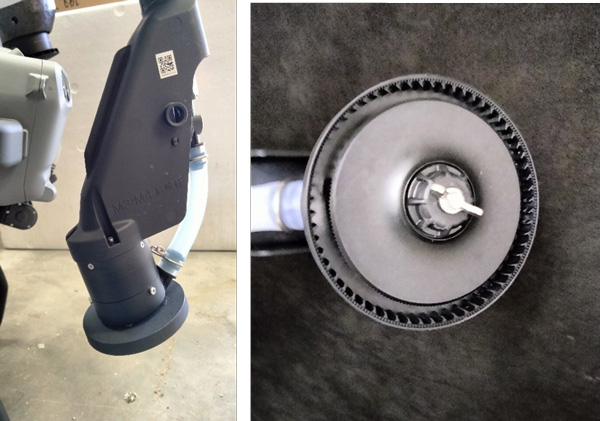Controlling tough weeds remains a challenge for Kansas growers, and chemical weed control remains the top strategy for their management in the state. Herbicides can be applied to crop fields using large row-crop sprayers, small hand-held or mounted sprayers, airplanes, or spray drones (Figure 1). The choice of application equipment depends on factors such as field size, field landscape, crop type, weed pressure, and socio-economic aspects. Among these methods, spray drone technology is gaining in popularity for herbicide applications. According to the American Spray Drone Association, in 2024, more than 10.3 million acres were treated with spray drones nationwide in more than 50 crops, providing $215 million in revenue for rural businesses.

Figure 1. Spray drone with white propellers made out of nylon carbon fiber filament and equipped with a dual atomizing spraying system (spray tank, centrifugal sprinklers, and magnetic drive impeller pumps), phased array radar system, and binocular vision system. Photo by Jeremie Kouame, Kansas State Research Extension
Characteristics of spray drones
Most commercial spray drones are the multi-rotor type. Current spray drone tank capacities typically range from around 2.5 gallons to 8 gallons and even up to 18 gallons, with some models offering larger capacities. The efficiency of the spray drone and the area it can cover are affected by several factors, including carrier volume (with 2 gallons per acre (GPA) commonly used), tank capacity, refill time, flight time and speed, spray swath width, nozzle type, nozzle number, flow rate, battery life and charging time. The application rate in row crops is usually between 1.5 to 2 GPA. The current flight time of many spray drones is about 7-10 minutes per battery. With its 18-gallon capacity and up to 30-foot swath width, the AG-272, manufactured in Texas by Hylio, is claimed to be able to cover up to 50 acres/hour at 2 GPA. Spray drones are equipped with multiple collision avoidance sensors and wireless remote controllers. Current models of drones have terrain sensors that maintain the optimum flight height to spray uneven and hilly terrain, automatically navigate hills and slopes, and avoid obstacles (Figure 2).

Figure 2. Rear phased array radar system for terrain follow. Photo by Jeremie Kouame, Kansas State Research and Extension.
Dual atomizing system
The newest design for discharging spray from drones uses rotary disc atomizers positioned under large propellers (Figure 3). The atomizer design and flow rate determine the droplet size and eliminates nozzle changes, pressure problems, and clogging. Moreover, rotating-disc-atomizer drones don’t have the clogging issues that hydraulic-nozzle drones have.

Figure 3. Spray lance and centrifugal sprinkler for a spray drone using a dual-atomizing spraying system. Photos by Jeremie Kouame, Kansas State Research and Extension.
Factors affecting herbicide deposition
Spray drones’ propeller downwash affects spray distribution. The turbulence created by the drones’ propellers improves droplet penetration into the canopy compared to traditional ground sprayers that are not air-assisted, which could probably improve the effectiveness of contact herbicides. However, downwash can be a factor that increases spray particles drift under conditions such as finer droplet sizes and increased flight heights and speeds. A study evaluating drift risk and nozzle types reported 81 to 95% higher spray drift risk for hollow cone nozzles than air-induction nozzles. Also, previous research suggested that extra-coarse nozzle could reduce downwind and airborne deposition compared to medium and fine nozzles.
Recommended uses for spray drones
Ditches, field borders, and roadsides. Weeds in ditches and along roadsides cause serious concern because of potential seed introduction into adjacent crop fields. Weeds in field margins, roadsides, and ditch banks can serve as a source for introducing and moving new weed species, including herbicide-resistant weeds. A best management practice is to prevent an influx of weeds by managing field borders. Spray drones can be used to control weeds in ditches and roadsides more efficiently than other weed control methods.
Site-specific management. Weed scientists have long recommended site-specific management strategies for reducing weed control costs. As weeds grow in patches in the fields, site-specific management can help target only field areas where weeds have escaped preemergence herbicide programs instead of a broadcast application, offering an opportunity to reduce the cost of postemergence herbicide programs. With the creation of high-resolution prescription maps, cost-effective postemergence herbicide applications can be achieved with spray drones. These targeted spraying maps can be created using drone imagery data from field scouting and some software programs such as PIX4Dfields.
Difficult soil conditions. When soil conditions are too wet due to the presence of standing water or present topographic limitations, such as too steep slopes or challenging terrains, making the use of other ground-based or other conventional methods of spraying challenging or not feasible, spray drones can become a good alternative. Some of the benefits of spray drones are that they allow a timely application of herbicides and can be used on fields with hills and terraces. Moreover, since spray drones do not come in contact with the soil, they do not create soil compaction issues that can impact water infiltration and crop root growth.
Harvest aids applications. Harvest aids can be important for efficient harvesting of certain crops. However, applying harvest aids with ground-based field sprayers can be very challenging as their wheels can roll over plants, break branches/tillers, and reduce yield. Spray drones can be safely used for harvest aid application without disturbing the crop. Previous research found harvest-aid performance sensitive to spray volume, with optimal defoliation efficacy attained with a 2.41 GPA and 8.95 mph flight speed.
Drones can be time-saving and labor-efficient
Due to the availability of GPS and LiDAR-based technology, drones nowadays can be programmed to fly over the field automatically without much human intervention. Such drone automation can rapidly spray herbicides throughout the field in a short period of time. Moreover, the drone's flight speed and height can be adjusted based on specific field needs. A single operator can efficiently manage the entire spraying operation, which is especially beneficial during peak seasons when labor availability is limited.
Despite the number of benefits and increasing popularity, such as site-specific weed management, less labor intensive, timesaving, and accessibility to hard-to-reach areas, drone applications still face challenges, such as limited payload capacity, battery life constraints, not suitable for larger areas and regulatory hurdles related to herbicide labeling and aerial application laws. Their adoption might increase as the technology improves, payload capacity keeps rising, and efficiency keeps improving.
Jeremie Kouame, Weed Scientist
jkouame@ksu.edu
Deepak Joshi, Precision Ag Specialist
drjoshi@ksu.edu
Sarah Lancaster, Extension Weed Scientist
slancaster@ksu.edu